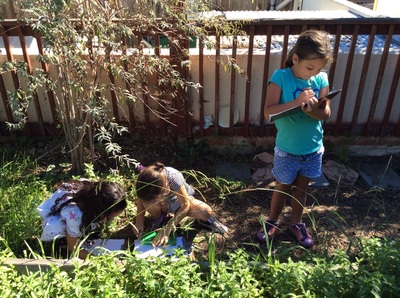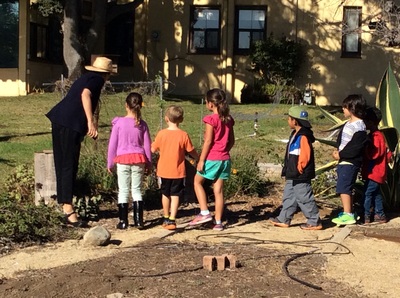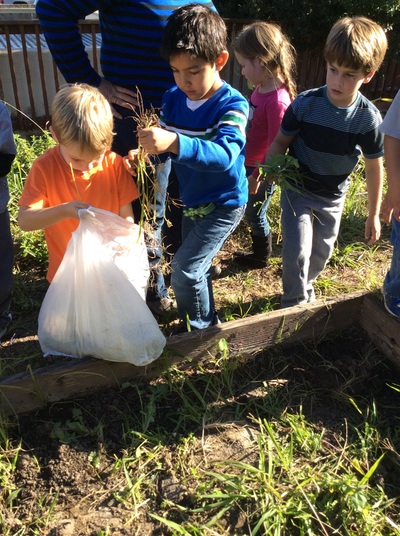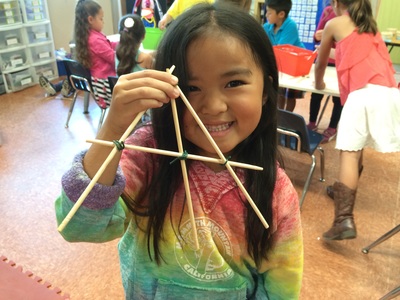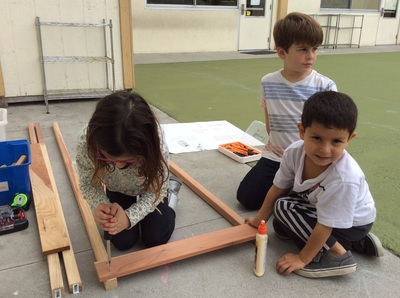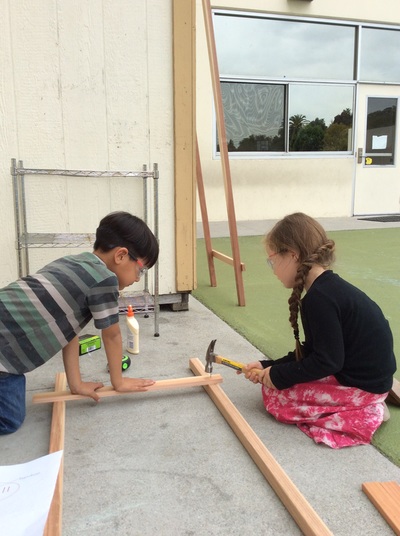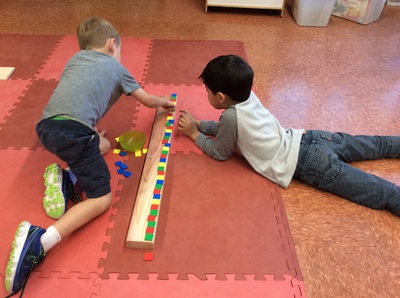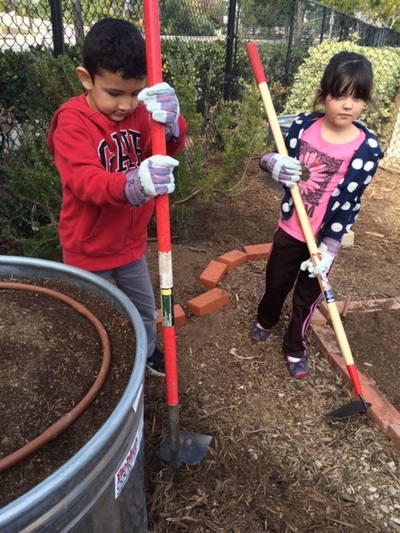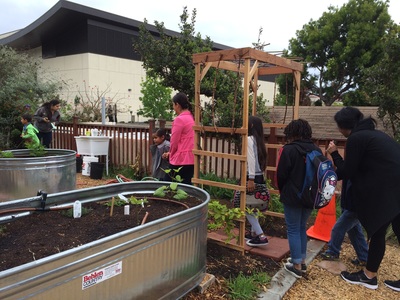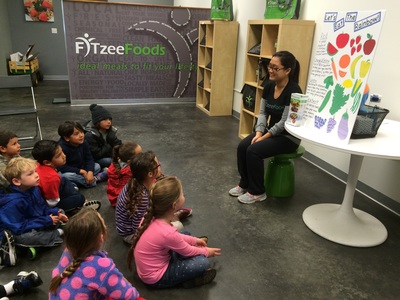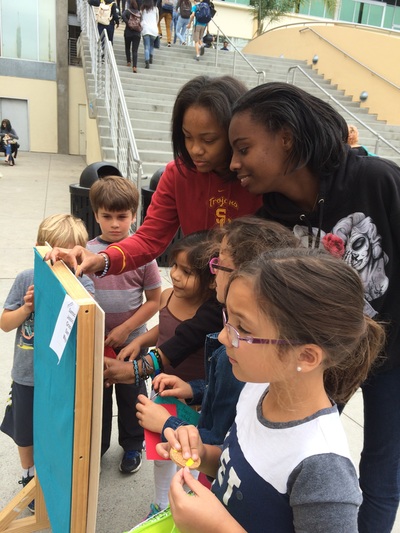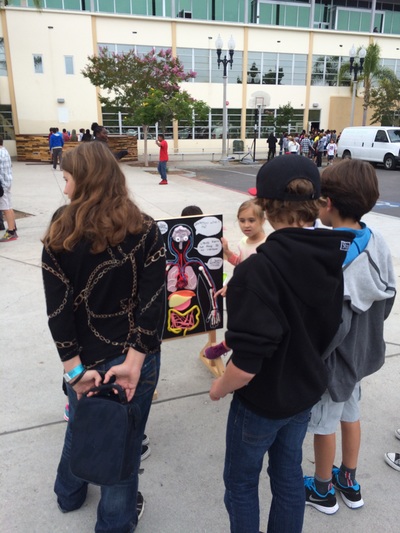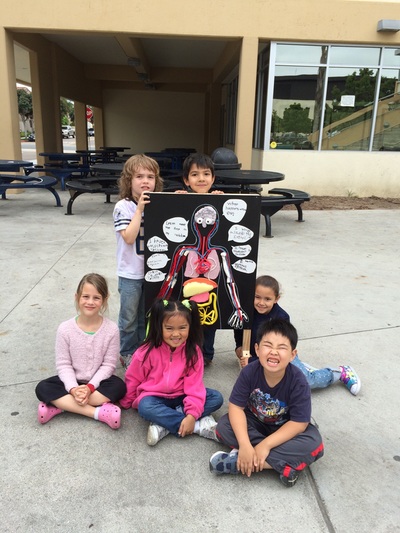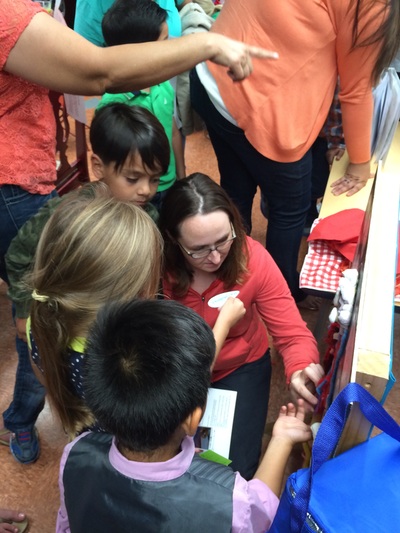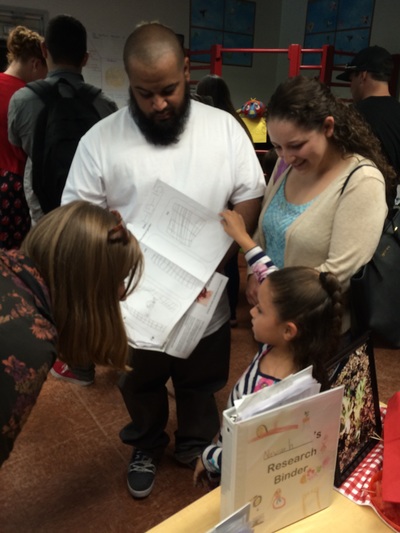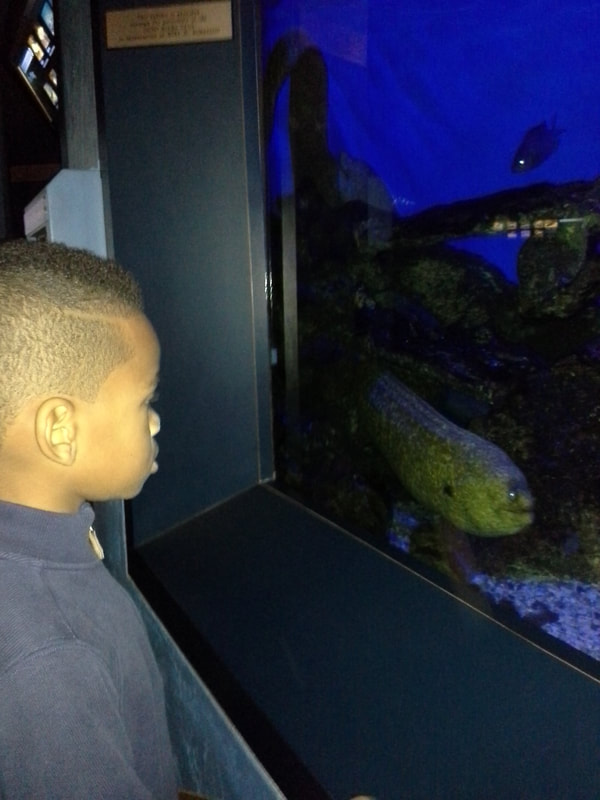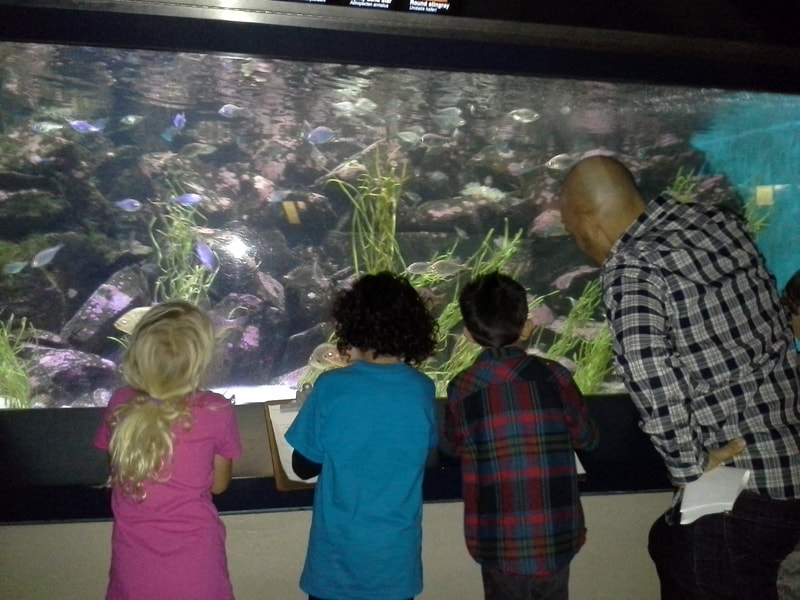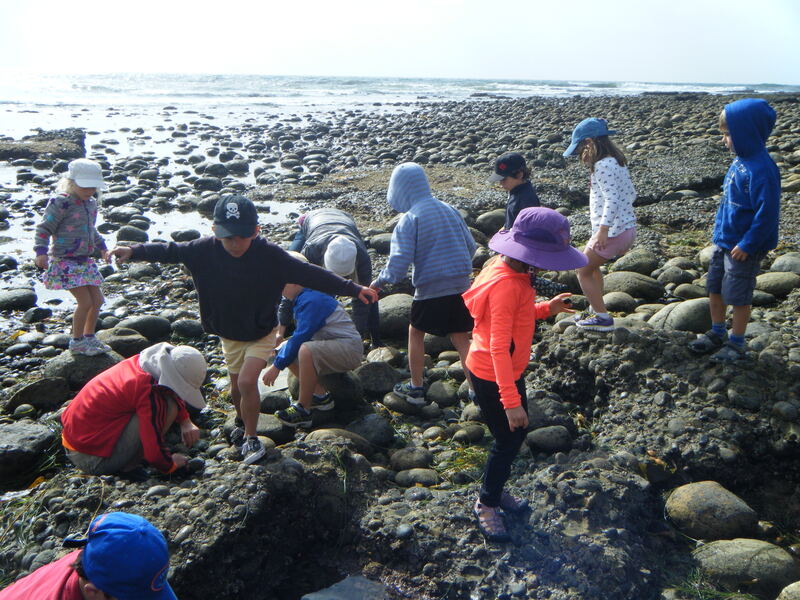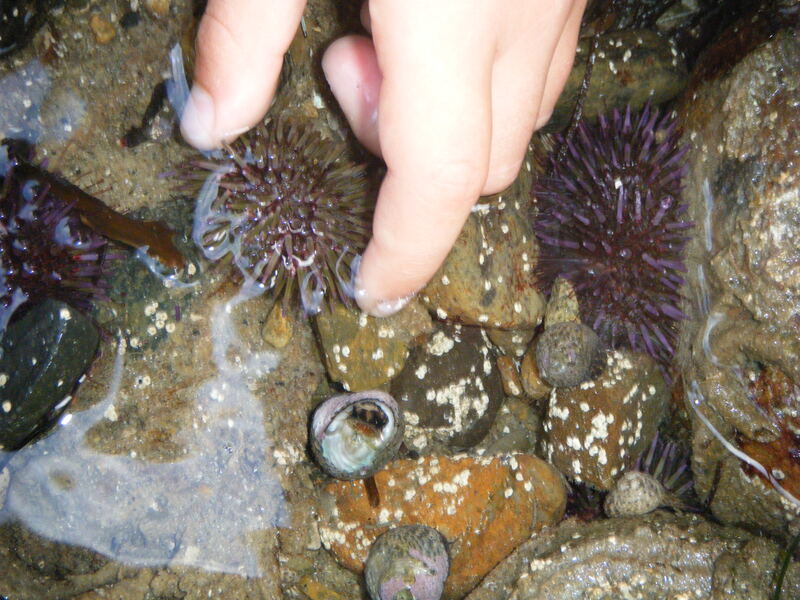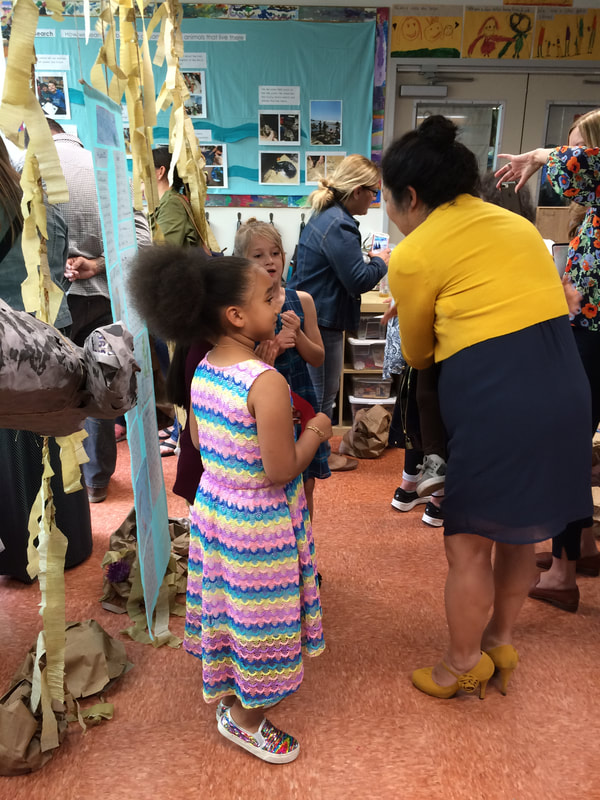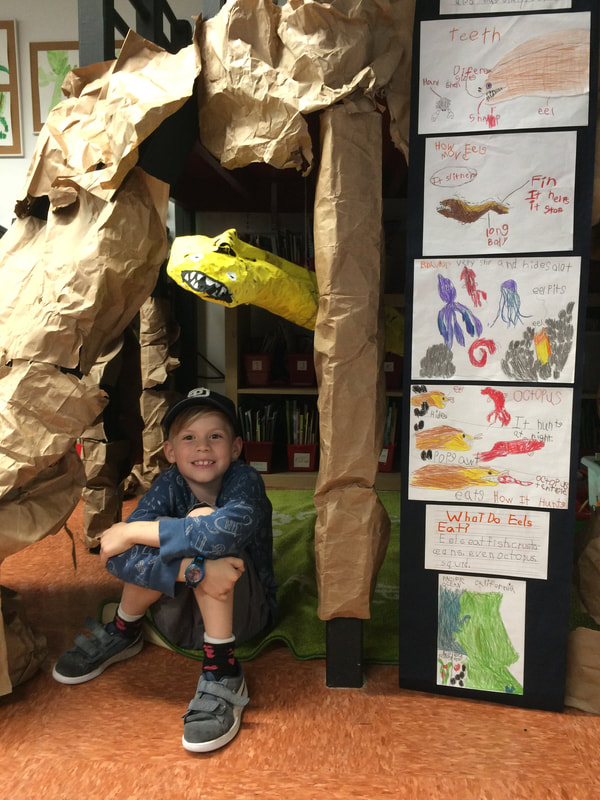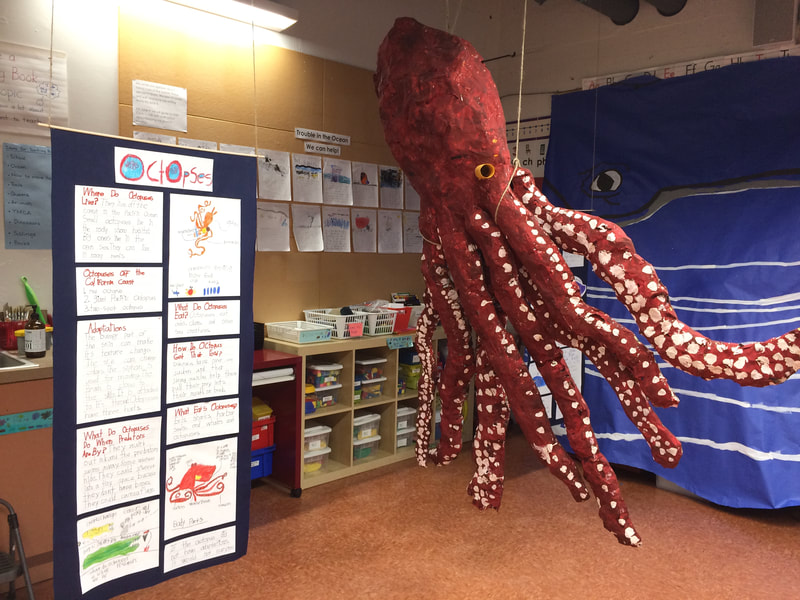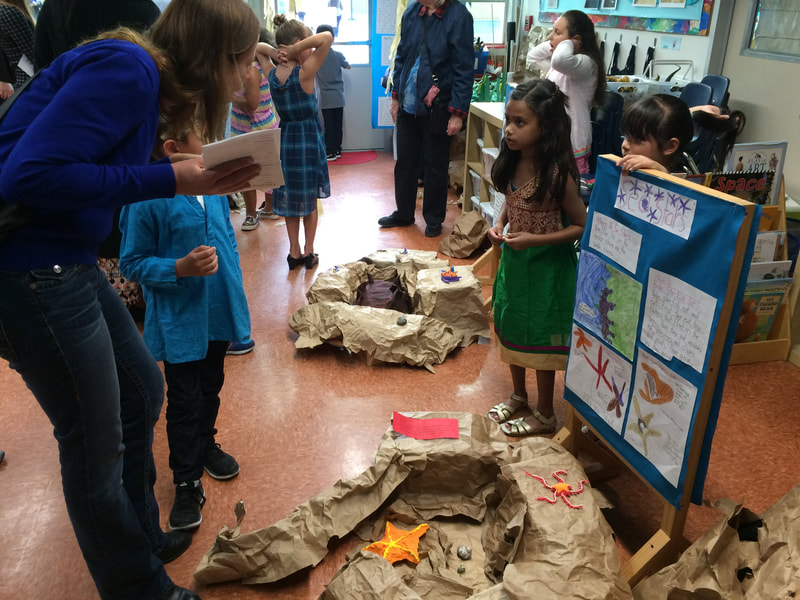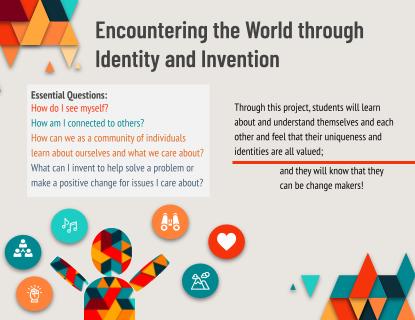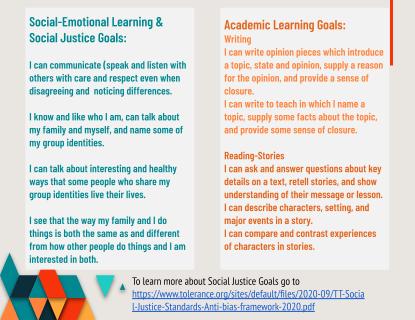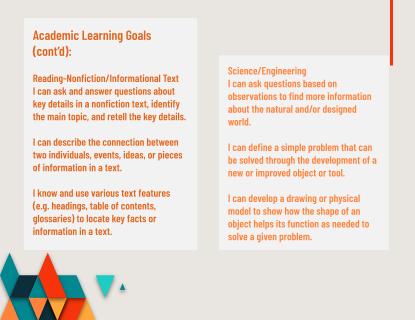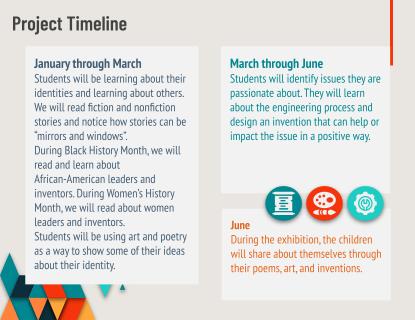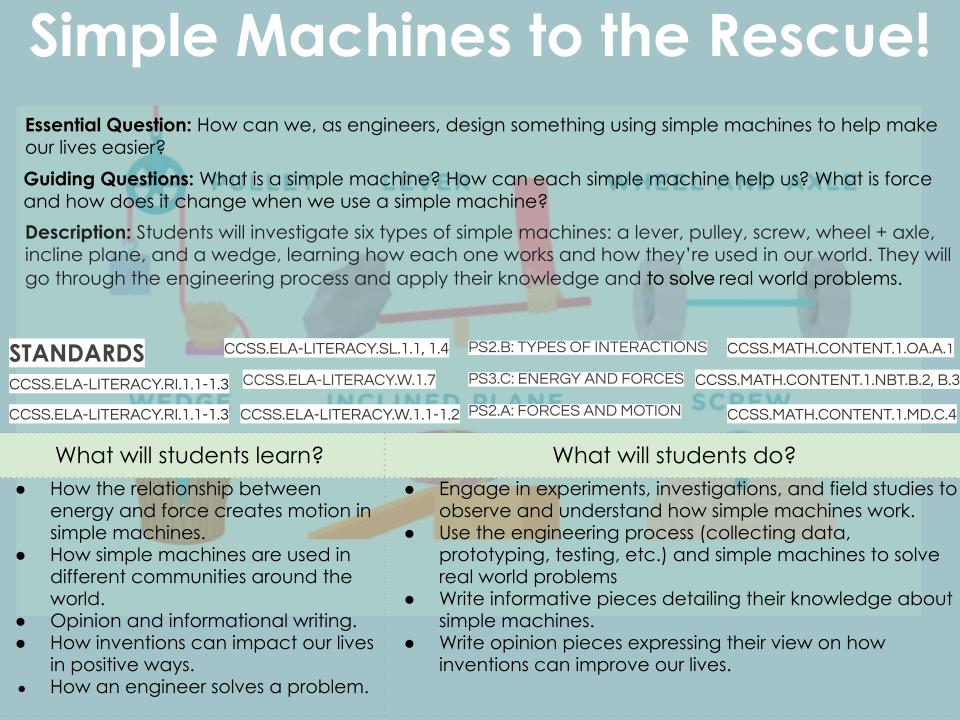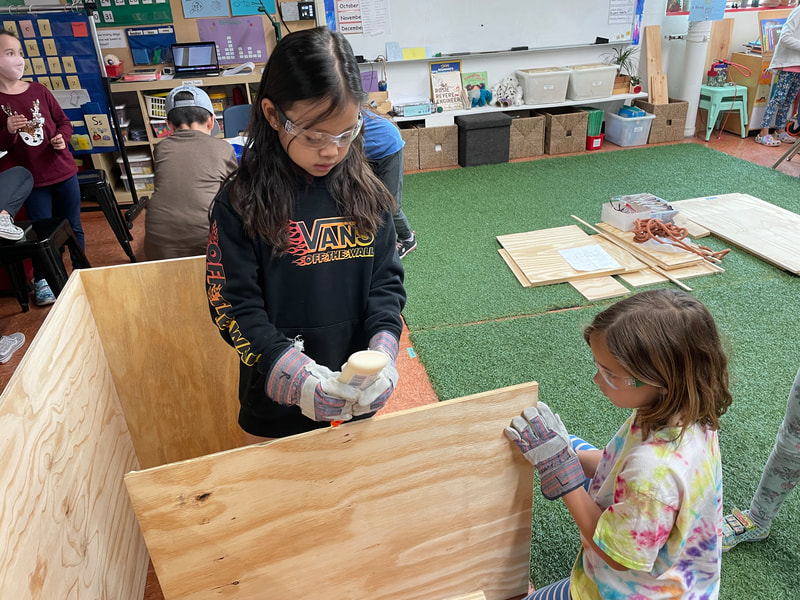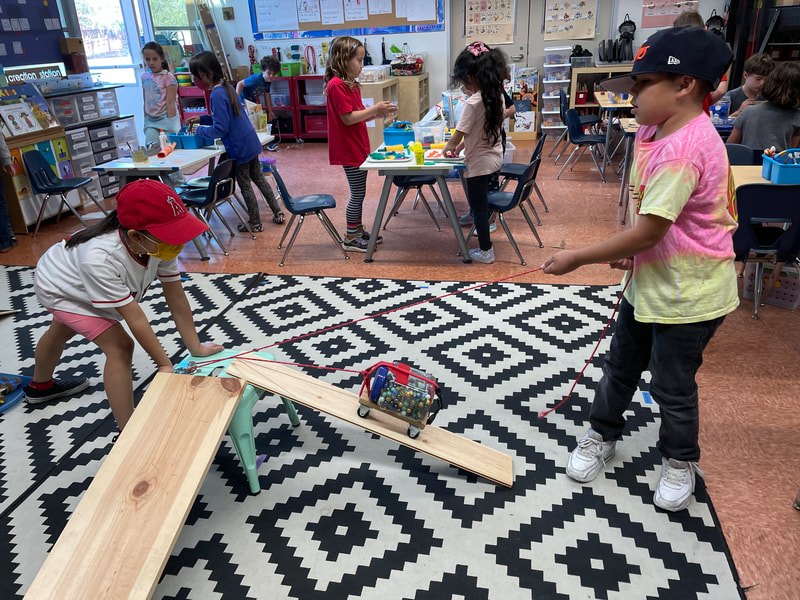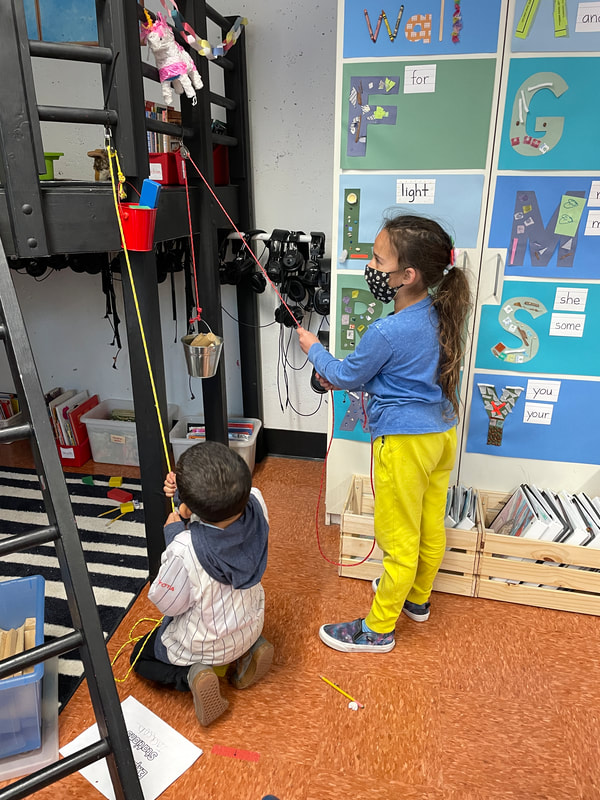This gives an overview or various projects. If you want to learn more details about them, go to the Newsletters link. It is full of updates and photos that show students' day-to-day activities.
The Building Blocks of Community
Beginning of the Year Project, Kinder 2016
Essential Questions
Who am I? Who are we?
Is it important to take care of each other? Why?
Learning Goals
Products
Students created art pieces in the form of large wooden blocks. Each student chose a word that represented an idea about her/himself or their community. The faces of the blocks will have writing, art, the beginning letter of the child's chosen word. These blocks can be used by the children throughout the year as toys. They can be moved and used to build structures. At the exhibition, the children built one sculpture that represented how we can take care of each other in our classroom community.
Beginning of the Year Project, Kinder 2016
Essential Questions
Who am I? Who are we?
Is it important to take care of each other? Why?
Learning Goals
- Community building
- Get to know self (uniqueness, hopes and dreams, feelings, strengths and needs, growth mindset)
- Get to know others (accept and appreciate differences, others' strengths and needs, others' feelings)
- Learn how to make sure everyone learns, feels safe, and has fun at school (develop classroom agreements)
- Phonemic Awareness
- Match letters to sounds
- Reading--comprehension, decoding
- Writing--use letters and sounds to compose words and sentences, letter formation, shared writing
- Art--illustration, drafting and critique, use various mediums
- Social-emotional skills--listening, speaking, reflection, empathy, noticing others’ feelings, self-regulation, problem solving, understanding that different people have different needs-know strategies to use to help self (movement, tool, etc.), sharing, understanding, recognizing, naming feelings, multiple perspectives, accepting and noticing differences
- Math--geometry, 2D and 3D shapes, construct 3D shapes using 2D shapes
- Engineering--design and construct rectangular prisms
Products
Students created art pieces in the form of large wooden blocks. Each student chose a word that represented an idea about her/himself or their community. The faces of the blocks will have writing, art, the beginning letter of the child's chosen word. These blocks can be used by the children throughout the year as toys. They can be moved and used to build structures. At the exhibition, the children built one sculpture that represented how we can take care of each other in our classroom community.
Click here to view slides that were used to help students reflect on their project process. They were also used to share the process with guests at the exhibition.
Click here to view slides that were used to help students reflect on their project process. They were also used to share the process with guests at the exhibition.
Click here to view slides that were used to help students reflect on their project process. They were also used to share the process with guests at the exhibition.
KINDER GARDENERS
Essential Questions
How can we grow our own food?
How can we make a beautiful, fun, new garden for our school?
Learning Targets
Project Process
The school garden was in desperate need of repair and renovation. The old wooden plant beds were rotting and the garden was overgrown with weeds and mint. Kindergarteners came to rescue and took on the challenge of designing and building a beautiful new garden for the school! The students used their research (from visiting the San Diego Botanical Garden and the High Tech High Media Arts garden and from reading) and their imaginations to come up with garden design ideas. They also conducted interviews to find out from teachers how they plan to use the garden and what they would like to have in it. Teachers wanted a sitting area for a class, garden beds, and pathways that make it easy to get around and reach areas for planting. The kindergarteners also had ideas of their own about what should be in our school garden. They wanted an arbor, bridge, trellises with vines, and a pond. They also felt that it would be important to have a variety of garden critters like ladybugs, spiders, worms, etc. The project was designed so that all these garden elements were included. The children had to learn about different kinds of plants and what they need in order to grow. They had to learn about how to design and build a bridge, an arbor, and trellises. Last, they had to learn about fish and how to create a pond system that could keep the fish and pond plants healthy.
Product
The students took apart the old garden, designed, and built a fabulous new one for the whole school to use! They also grew some vegetables and fruits in some of the garden beds. At the exhibition, the students gave tours of the garden and invited other classes and their teachers to use the available garden beds. They also gave tours to families at our school.
Essential Questions
How can we grow our own food?
How can we make a beautiful, fun, new garden for our school?
Learning Targets
- Reading-decoding, fluency, comprehension
- Writing-expository writing
- Research skills (generating questions, finding answers)
- Presentation
- Gardening
- Art-drawing garden designs/layout
- Math-measurement, geometry
- Engineering-design, building and testing prototypes, constructing structures for the garden
- Scientific process
- Science-
- Plants: living/non-living things, a plant is a system--parts, what they need to live, where their energy comes from, edible/inedible, we get our energy from eating plants, nutrients from plants
- Animals: animals that are found in the garden, living/non-living, plants and animals are interconnected—the garden is a system, which plants are helpful/harmful to the garden
Project Process
The school garden was in desperate need of repair and renovation. The old wooden plant beds were rotting and the garden was overgrown with weeds and mint. Kindergarteners came to rescue and took on the challenge of designing and building a beautiful new garden for the school! The students used their research (from visiting the San Diego Botanical Garden and the High Tech High Media Arts garden and from reading) and their imaginations to come up with garden design ideas. They also conducted interviews to find out from teachers how they plan to use the garden and what they would like to have in it. Teachers wanted a sitting area for a class, garden beds, and pathways that make it easy to get around and reach areas for planting. The kindergarteners also had ideas of their own about what should be in our school garden. They wanted an arbor, bridge, trellises with vines, and a pond. They also felt that it would be important to have a variety of garden critters like ladybugs, spiders, worms, etc. The project was designed so that all these garden elements were included. The children had to learn about different kinds of plants and what they need in order to grow. They had to learn about how to design and build a bridge, an arbor, and trellises. Last, they had to learn about fish and how to create a pond system that could keep the fish and pond plants healthy.
Product
The students took apart the old garden, designed, and built a fabulous new one for the whole school to use! They also grew some vegetables and fruits in some of the garden beds. At the exhibition, the students gave tours of the garden and invited other classes and their teachers to use the available garden beds. They also gave tours to families at our school.
WHY DO WE EAT?
Essential Questions
Why do we eat?
What do Explorer kindergarteners eat?
What happens to the food we put into our bodies?
Learning Targets
- Science:
- Human body systems/functions (circulatory, respiratory, muscular, skeletal, and nervous)
- Basic vitamins and minerals and benefits for body/how they’re used by the body
- Vitamins and minerals from the specific crops we grew in our garden
- Math-data collection, analysis, presentation
- Reading-decoding, fluency, comprehension
- Research skills
- Expository writing and persuasive writing
- Art-illustration
- Social-emotional skills-Collaborating, sharing, taking turns, speaking and listening, presenting
Project Process
To answer these questions, the kindergarteners did some research. They collected data, read books, learned from websites, did taste tests, and talked to an expert nutritionist. Students learned about the human body. They learned about the different systems in the body and how they work. There are student experts on the digestive system, muscular system, skeletal system, respiratory system, circulatory system, and nervous system in each nutrition game group. Each game group learned about a fruit or vegetable that we grew in our garden. They learned about what nutrients a person would get if he or she ate that fruit or vegetable.
Product
To encourage others to eat healthy food, the kindergarteners made a game other children can play at lunch time to teach them about nutrition. They taught some high school students and middle school students at High Tech High Media Arts. They taught 5th graders and 4th graders at Explorer. Then, they taught their friends and families and the community at the Ocean Beach Farmer's Market.
To view another iteration of this project click here.
To watch a student video about how to play the game, click here.
Click here to view slides that were used to help students reflect on their project process. They were also used to share the process with guests at the exhibition.
Ocean Explorers
Essential Questions
What lives in the ocean? What are their special structures and behaviors that help them survive in their habitat?
How is the ocean a system?
How can we make sure these animals are safe and healthy? Why do we need to keep them safe and healthy?
Learning Targets
Science
Animals of the California Coast: octopus, leopard shark, blue whale, lobster, eel, crab, jellyfish, sea star, sea horse, garibaldi, sea slug/hare, squid
Structure and Function
Cause and Effect
Math: Beach clean-up--collect trash data and analyze its impact, measurement to make life-sized sculptures of the animals
Art: make sculptures--Paper mache animals, model magic animals, other materials for habitat (kelp, rocks, caves, water, etc.)
Social-emotional skills: work with partner to do research and products--take turns, decisions making, sharing materials, etc., presentation skills-partners present at each station (by their animal), present to visitors at La Jolla Cove to tell them about caring for the animal habitiats
Writing: opinion writing--persuade others to take good care of our ocean and its creatures
Reading: decoding, fluency, comprehension-shared reading for research, small group reading instruction with partners for research
Learning Process
Our community lives right by the beautiful California Coast. This is something that we cherish and enjoy, and so we need to care for it. Students were excited to apply some of what they learned about adaptations from their study of plants in the previous project to the is one about ocean animals. They did some research and did some work as scientists--they asked questions, made observations, recorded their learning in words and models, and analyzed data. They figured out how the structures on animals' bodies helped them to survive in their habitat. They also learned about how the animals work together as a system. They did research through science investigations, reading, videos, and field work at the Birch Aquarium at Scripps Institute of Oceanography and local tide pools. Guest experts from the Marine Ecology & Biology Student Association of San Diego State University came to the classroom with some of the animals from our nearby ocean to help the students grow in their understanding of animal adaptations.
Lastly, the children thought about how we humans affect the ocean and its creatures, and what we can do to make sure it is safe and healthy. They did some research on this topic through science investigations and reading. Experts from I Love a Clean San Diego shared some of their knowledge about this topic as well. Students learned how to write about their opinions to persuade others to care for the ocean.
Product
The students turned the classrooms into a "swim-through" ocean exhibit. Children from other classrooms swam through the exhibit and learned about the animals and their habitats from our ocean experts and their life-sized models. The students also went to La Jolla Cove, a popular San Diego destination, and taught visitors about ways they can help keep the animals and their habitats healthy.
What lives in the ocean? What are their special structures and behaviors that help them survive in their habitat?
How is the ocean a system?
How can we make sure these animals are safe and healthy? Why do we need to keep them safe and healthy?
Learning Targets
Science
Animals of the California Coast: octopus, leopard shark, blue whale, lobster, eel, crab, jellyfish, sea star, sea horse, garibaldi, sea slug/hare, squid
Structure and Function
- All organisms have external parts. Different animals use their body parts in different ways to see, hear, grasp objects, protect themselves, move from place to place, and seek, find, and take in food, water and air. Plants also have different parts (roots, stems, leaves, flowers, fruits) that help them survive and grow. (1-LS1-1)
- The shape and stability of structures of natural and designed objects are related to their function(s). (1-LS1-1) (adaptations)
Cause and Effect
- Events have causes that generate observable patterns. (2-LS2-1)-2nd grade (Human impact)
Math: Beach clean-up--collect trash data and analyze its impact, measurement to make life-sized sculptures of the animals
Art: make sculptures--Paper mache animals, model magic animals, other materials for habitat (kelp, rocks, caves, water, etc.)
Social-emotional skills: work with partner to do research and products--take turns, decisions making, sharing materials, etc., presentation skills-partners present at each station (by their animal), present to visitors at La Jolla Cove to tell them about caring for the animal habitiats
Writing: opinion writing--persuade others to take good care of our ocean and its creatures
Reading: decoding, fluency, comprehension-shared reading for research, small group reading instruction with partners for research
Learning Process
Our community lives right by the beautiful California Coast. This is something that we cherish and enjoy, and so we need to care for it. Students were excited to apply some of what they learned about adaptations from their study of plants in the previous project to the is one about ocean animals. They did some research and did some work as scientists--they asked questions, made observations, recorded their learning in words and models, and analyzed data. They figured out how the structures on animals' bodies helped them to survive in their habitat. They also learned about how the animals work together as a system. They did research through science investigations, reading, videos, and field work at the Birch Aquarium at Scripps Institute of Oceanography and local tide pools. Guest experts from the Marine Ecology & Biology Student Association of San Diego State University came to the classroom with some of the animals from our nearby ocean to help the students grow in their understanding of animal adaptations.
Lastly, the children thought about how we humans affect the ocean and its creatures, and what we can do to make sure it is safe and healthy. They did some research on this topic through science investigations and reading. Experts from I Love a Clean San Diego shared some of their knowledge about this topic as well. Students learned how to write about their opinions to persuade others to care for the ocean.
Product
The students turned the classrooms into a "swim-through" ocean exhibit. Children from other classrooms swam through the exhibit and learned about the animals and their habitats from our ocean experts and their life-sized models. The students also went to La Jolla Cove, a popular San Diego destination, and taught visitors about ways they can help keep the animals and their habitats healthy.
The Power of Yet and Our Other Powers
Click here to view slides that were used to help students reflect on their project process. They were also used to share the process with guests at the exhibition.
Encountering the World through Identity and Invention
This project was done during the pandemic. The 1st part of this project was done through distance learning, then later as a combination of in-person and distance learning instruction.
The Light of Kindness
Click here to view slides that were used to help students reflect on their project process. They were also used to share the process with guests at the exhibition.
Lights, Access, Action!
Click here to view slides that were used to help students reflect on their project process. They were also used to share the process with guests at the exhibition.
